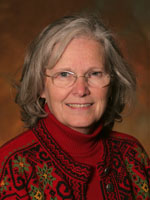
Dagmar Ringe
Brandeis University
Cogs, Knobs, and Switches
My very first Gordon Conference was the 1982 Enzymes, Coenzymes, and Metabolic Pathways Conference at Kimball Union Academy in Meriden, New Hampshire. Together with Gregory Petsko I brought along an electron density map on stacked sections so that the enzymologists could see for themselves what the structure of an enzyme looks like and how crystallographers were getting their results. Seeing the arrangement of atoms in space could clarify how the parts come together to make such an exquisite machine, complete with cogs, knobs, and switches that could perform a chemical job unique to the work of an enzyme. There was only one problem with this engineer’s view of the world; my favorite biochemist, Robert Abeles, told me that the structures we were seeing could not possibly be right because the results suggested rigid molecules–and enzymes are not rigid. This was the start of a wonderful, exciting, and rewarding journey through structural enzymology.
The work of our research group and of other structural enzymologists showed that enzymes are indeed not rigid and that they respond to the presence of ligands. Enzymes also harbor surprises that only their structure can show. In some cases even the details of how the cogs, knobs, and switches work can be demonstrated, which stimulates notions about how to interfere with them and thereby manipulate enzyme fuction.
Since that first conference in 1982 I have attended a number of different Gordon Conferences, some highly focused, others more general in scope. At each one I have learned a great deal, have met wonderful scientists, and have come away with new ideas and collaborations. In fact, one of my most fruitful collaborations, with Jack Kirsch, was initiated by a casual encounter at the swimming hole during the Enzymes, Coenzymes, and Metabolic Pathways Gordon Conference. I cannot imagine a better way of meeting–on a sweltering day, luxuriating in a cold stream and discussing the chemistry of biological systems. Other collaborations were born during tennis games or on hikes. I am still developing collaborations from such serendipitous meetings. These special encounters–the opportunities to talk about science in an informal setting–are what set the Gordon Conferences apart in my mind.
Science does not stand still, and new ideas are constantly changing the way we approach it. Structural biology has had a major impact on the way biologists think. The Gordon Conferences have played a major role in providing a venue where new ideas and new approaches can be learned and accepted. I have been fortunate to be part of the revolution that brought considerations of structure into biochemistry and biology, and I anticipate continuing to be part of the changes that new insights will bring.